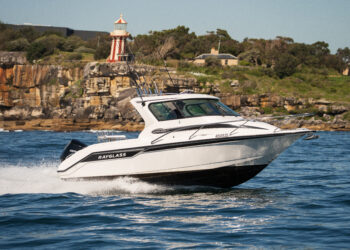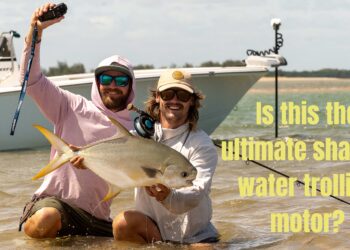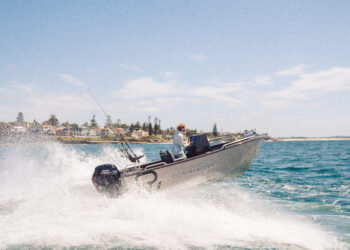FOR the past several months Fisho has been part of an international testing program helping fine-tune Raymarine’s pro-grade deep water chirp sounder module, the CP570. This unit, which was released in August, is compatible with all a, c, e, eS and gS Raymarine MFDs. It’s designed primarily as a blue water fishing tool in that it has the ability to run dual range signals from a single transducer. The benefits this technology offers are significant … But more on that later.
The testing work we’ve done on the CP570 has been interesting on a number of levels. First up is a realisation of just how much programming and fine-tuning is required to get high-level marine electronics up to scratch. The boffins at Raymarine’s HQ in England have provided numerous software updates over the testing period, most of which have eventuated from data provided from the international testing panel. We’ve been required to submit regular reports and data from the testing work we’ve done, most of which has been focused on deep-water use. It’s been interesting to see the unit’s performance improve with each update. The final version, which is available from Raymarine dealers as you read this, should be pretty much “bug free”, although further software updates will doubtless be offered.
As mentioned previously, the CP570 is designed for deep-water work in depths of 50 fathoms plus. I’ve used the unit in much shallower water and found it very effective at marking fish such as snapper on the edges of reefs and bommies in water ranging from 15-30 fathoms. However, you don’t need a sounder with as much grunt as the 570 to do that. This sort of equipment comes into its own out around the shelf line in waters from 100-300 fathoms.
The Fisho project boat, a plate alloy Bar Crusher 670HT, is fitted with a transom mounted TM265 CHIRP transducer. Compared to a standard 600W transducer, the TM265 offers significantly more power and sensitivity. However, the TM265 can’t compare to the 2kW and 3kW through-hull transducers that can be mounted in fibreglass sportfishing boats. The CP570 is suited for use with these big transducers, opening up extreme depth sounding capability for boats able to mount a sizeable through-hull ‘ducer. I understand a charter boat using the CP570 in conjunction with a 3kW through-hull transducer has recorded depths up to 1500 fathoms. That’s insanely deep!
Impressive performance
With the TM265 I’ve recorded bottom readings in 200+ fathoms, both at slow speeds and on the plane. The screen shot above shows a clear bottom reading in 226 fathoms at a speed of 17 knots. That is impressive performance for a transom mount transducer on a relatively small alloy boat. The screen shot on the following page shows a clear reading of fish (probably leatherjackets) at 80 fathoms inside the shelf east of Jervis Bay while travelling at nearly 23 knots. These results demonstrate the speed of the processors working inside the CP570 module. We’re talking serious computer power …
While the CP570 is obviously pretty good at picking up and displaying clear bottom detail in deep water, the really interesting aspect of Raymarine’s new sounder technology is that it allows the user to select a “dual range” function. This basically turns the 570 into two different sounders both using the same transducer. For example, the unit can be set at a Low frequency setting to pick up bottom detail in deep water while a Medium or High frequency can be used to scan top and mid water depths. The benefits of this were recently explained to me by Raymarine’s local depth sounder guru, Grant Watson.
“Say you’re in water about 400 fathoms deep,” Grant said. “A low frequency sounder ‘ping’ takes about one second to get down there and bounce back up again. With the dual range capability of the 570, you can also set a high frequency ‘ping’ at, say, 100 fathoms to look for bait or pelagics like marlin or tuna. At this depth, the high frequency return is four times faster than the low frequency so you’re getting far more accurate coverage of the water and giving yourself a far better chance of finding bait or getting a return from a fast moving pelagic.”
In very simplistic terms, the CP570 gives users the ability to scan the bottom for structure in the form of canyons, drop-offs and deep reef – as well as finding fish positioned on or near such structure – while at the same time accurately probing the mid water for all important bait schools and/or any gamefish lurking about. Anyone who’s chased marlin will know the importance of finding the bait. Finding and staying with the bait schools is often the difference between hook-ups and zeros. A standard sonar set for deep water use will send back slow returns, meaning you may well drive past the bait or fish before you see anything. The 570, on the other hand, is designed to deliver the best of both worlds: deep-water performance with lightning fast returns of mid water bait and/or predators.
Sonar technology has come so far so quick it’s very hard for the average fisho (like me and you) to keep up with the changes. Suffice it to say, new software like that developed by Raymarine for its top-of-the-line CP570 will doubtless filter down to smaller units designed for inshore and estuary sportfishing boats. This technology will definitely make it easier to find fish and fish-holding structure. It then up to us as anglers to actually catch the damn things!
RRP for the CP570 module is $2995.
Find out more about the CP570 and the entire range on the Raymarine website.




















